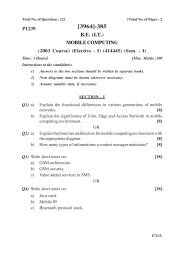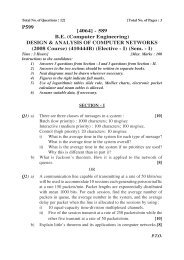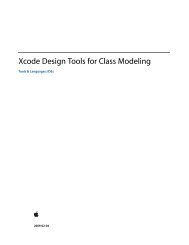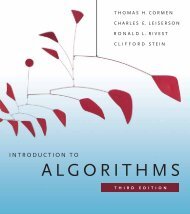Cloud Computing and SOA Convergence in Your Enterprise: A Step ...
Cloud Computing and SOA Convergence in Your Enterprise: A Step ...
Cloud Computing and SOA Convergence in Your Enterprise: A Step ...
Create successful ePaper yourself
Turn your PDF publications into a flip-book with our unique Google optimized e-Paper software.
112 Chapter 6 Work<strong>in</strong>g from <strong>Your</strong> Services to the <strong>Cloud</strong>s<br />
<strong>in</strong>stances, provid<strong>in</strong>g better resource utilization <strong>and</strong> scalability. In essence,<br />
you talk to the applications through the services <strong>in</strong>terface. The<br />
location where the <strong>in</strong>stance actually runs is transparent to you.<br />
We have the ability to mix <strong>and</strong> match services for use with<strong>in</strong> composite<br />
applications or composite processes. This provides the agility aspect with<br />
the use of cloud comput<strong>in</strong>g architecture <strong>and</strong> <strong>SOA</strong>. Not only can you create<br />
application processes quickly to solve bus<strong>in</strong>ess problems, but you can<br />
recreate them as needed <strong>and</strong> thus provide the core value of agility. The<br />
use of cloud comput<strong>in</strong>g provides even more value because we do this us<strong>in</strong>g<br />
more cost-effective comput<strong>in</strong>g platforms.<br />
Thus, we have the purpose of this chapter: the need to deal with all of<br />
our IT assets as services. We must def<strong>in</strong>e them with enough detail to figure<br />
out how they work <strong>and</strong> play well with<strong>in</strong> our <strong>SOA</strong> <strong>and</strong> how some of those services<br />
may reside on cloud platforms if we need them to live there. Assum<strong>in</strong>g<br />
that you are an enterprise or <strong>SOA</strong> architect, we provide you with enough <strong>in</strong>formation<br />
about the “how” that you can be productive <strong>in</strong> your own cloud<br />
comput<strong>in</strong>g replatform project.<br />
Before we cont<strong>in</strong>ue with our case study, let’s get back to the basics.<br />
Services Provide the Mov<strong>in</strong>g Parts<br />
We look at our architecture as a collection of services, <strong>and</strong> thus as an <strong>SOA</strong>,<br />
because it is much easier to break the architecture down to a logical, functional<br />
primitive <strong>and</strong> build it back up as a def<strong>in</strong>ed set of services. Once we do<br />
that, we have a start<strong>in</strong>g po<strong>in</strong>t for figur<strong>in</strong>g out which services should exist onpremise<br />
<strong>and</strong> which services should potentially reside <strong>in</strong> the cloud (see Figures<br />
6.1 <strong>and</strong> 6.2).<br />
We build services on top of data or <strong>in</strong>formation, which we def<strong>in</strong>ed <strong>in</strong> the<br />
previous chapter as the <strong>in</strong>formation model. We did that first because services<br />
typically process <strong>in</strong>formation or are bound to data. In many <strong>in</strong>stances, it is<br />
much easier to def<strong>in</strong>e services after def<strong>in</strong><strong>in</strong>g data, but some choose to do the<br />
reverse, from the services to the data. Either way works, <strong>and</strong> how you approach<br />
this depends on your problem doma<strong>in</strong> <strong>and</strong> on your own requirements<br />
<strong>and</strong> preferences.<br />
At this po<strong>in</strong>t, you have a data-level underst<strong>and</strong><strong>in</strong>g of your problem doma<strong>in</strong>,<br />
<strong>and</strong> now we move up to a service-level underst<strong>and</strong><strong>in</strong>g (see Figure 6.3).












